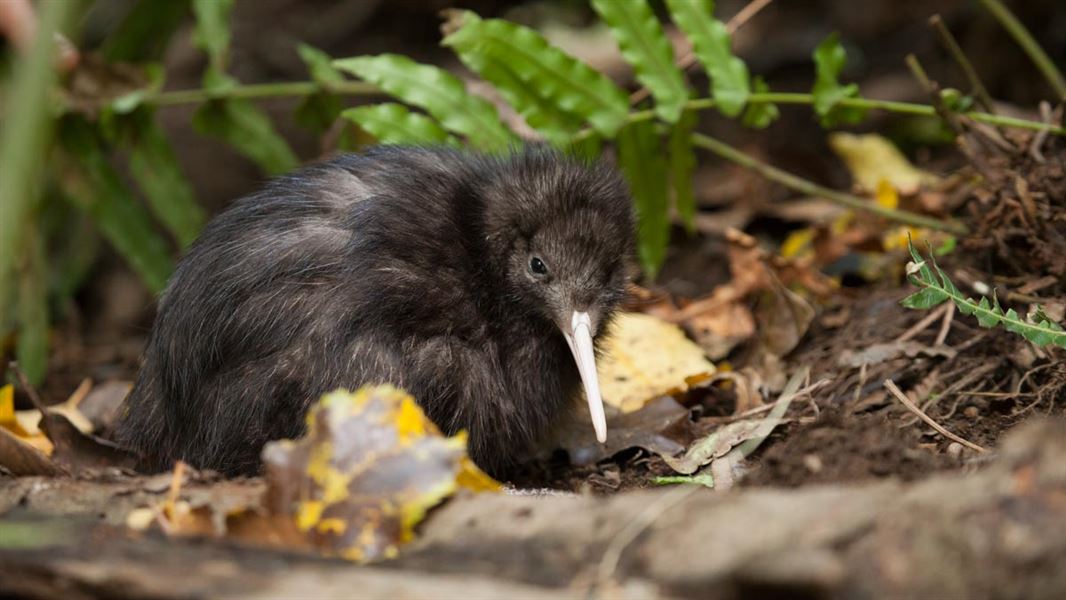National status: Endemic
Conservation status: Varies between species from Recovering to Nationally Critical
Threats: Predation, human impacts, risks from small population size
Sound recordings
Kiwi: Male North Island brown kiwi song (MP3, 558K)
00:35 – Male brown kiwi calling his mate.
Kiwi: Female North Island brown kiwi song (MP3, 2252K)
02:24 – Female brown kiwi calling her mate.
Species information: Kiwi on NZ Birds online
Species
Did you know?
There are about 70,000 kiwi left. We're losing 2% of our unmanaged kiwi every year – that's around 20 per week.
Kiwi are ratites. The closest relatives to today’s kiwi are the extinct elephant birds from Madagascar. They are also related to emus and cassowaries of Australia, and the extinct moa of New Zealand.
There are five species of kiwi:
Kiwi can live for between 25 and 50 years. Chicks hatch fully feathered. They emerge from the nest to feed at about five days old and are never fed by their parents. Juveniles grow slowly, taking three to five years to reach adult size.
Cultural importance
Kiwi are a significant national icon, equally cherished by all cultures in New Zealand. Kiwi are a symbol for the uniqueness of New Zealand wildlife and the value of our natural heritage.
The bird itself is a taonga (treasure) to Maori, who have strong cultural, spiritual and historic associations with kiwi. Its feathers are valued in weaving kahukiwi (kiwi feather cloak) for people of high rank.
Due to the cultural significance to Maori and the traditional knowledge about the bird, tangata whenua are a key stakeholder in kiwi management. For a number of local iwi and hapu throughout New Zealand, this relationship between tangata whenua and kiwi has been formally recognised as part of their Treaty of Waitangi settlement claims, which encompass specific references to species recovery work. This includes the Ngai Tahu Claims Settlement Act 1998.
Community involvement
Kiwi have become flagship species for conservation and are often used as a measure for the state of our natural environment and the outcome and value of community conservation projects.
Today, more than 90 community and iwi-led groups actively protect kiwi over a combined area estimated to be 230,000 ha – very similar to the amount of public conservation land protected by DOC for kiwi. Land is managed for wild populations, as well as at fenced predator-proof sites and on predator-free islands
Threats to kiwi
Kiwi can't fly, have under-developed wing and chest muscles, and lack a sternum (breastbone). This makes them particularly vulnerable to crushing injuries, such as those caused by dog bites.
The biggest threat to kiwi chicks is stoats, and to adult kiwi it's dogs. Cats also kill kiwi chicks, and ferrets frequently kill adult kiwi.
Introduced mammals can also have a wider impact on kiwi. Competition by rodents for similar food appears to delay growth of kiwi chicks which increases pressure on the overall population at some sites. Rats are food for stoats – when there are lots of rats, there are lots of stoats.
In areas where we control predators, kiwi numbers are increasing. On the Coromandel for example, the kiwi population is doubling every decade thanks to intensive predator control.
Other threats include habitat modification/loss and motor vehicle strike, as well as the small population size and distribution of some species. New avian disease and parasites that may reach New Zealand present a further threat to kiwi populations.
Stoats
In most parts of the country, stoats are responsible for approximately half of kiwi chick deaths on the mainland. Without management only 10% of kiwi chicks survive to the age of six months. Young kiwi chicks are vulnerable to stoat predation until they reach about one kilogram in weight, at which time they can usually defend themselves against stoats.
Dogs
Dogs frequently kill adult kiwi and can cause catastrophic declines in local populations.
All dogs, regardless of size, breed, training or temperament are potential kiwi killers. A dog can kill a kiwi by just giving it a playful push.
In Northland, the life expectancy of adult Northland brown kiwi has been reduced to just 14 years on average, due to dogs.
Small population size
Risks to small populations of kiwi include loss of genetic diversity, inbreeding, and vulnerability to localised dramatic events such as fire, disease or predator increases.
Limited dispersal and associated lowered chances of finding a mate in declining, small populations can also lead to lower reproductive rates, worsening the effect of the decline.
